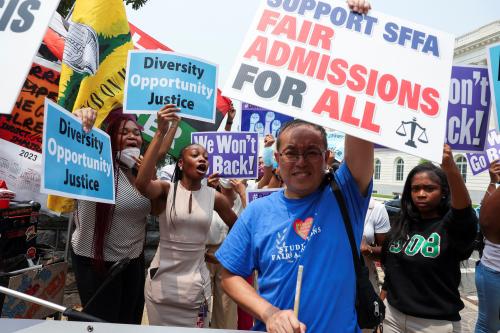On July 14, the Trump administration agreed to rescind the policy that would have required international students to take in-person classes in order to remain in the U.S.
Last week, U.S. Immigration and Customs Enforcement (ICE) released new guidelines for international students in America. International students now must either resume in-person classes—amid rising coronavirus case counts—or leave the country. Before the coronavirus outbreak, international students could take only one class remotely. However, due to the quick transition to virtual instruction in mid-March, immigration authorities put in place a temporary exemption to permit students to continue their coursework exclusively online while maintaining lawful status. Last Monday, ICE announced the end of this temporary waiver, requiring international students to take at least one in-person class.
I am one of the students affected by these guidelines. After completing a master’s degree in the U.S., I got a job at Brookings in 2015, work that was initially authorized under Optional Practical Training (OPT) on my F-1 student visa and then later through an H1-B visa. I started as a Research Assistant and have moved up through the ranks, now working as a Senior Research Analyst. Now, I’m ready to take the next step and pursue a Ph.D. This past spring, I received wonderful news: I had been admitted to a top-ranked Ph.D. program, here in the U.S., where I would be trained by remarkable faculty members to study policies and practices to address issues of educational inequality. Yet, the recent guidance has put this career path in serious jeopardy.
Implications of the new rule across institutional plans for reopening
ICE’s decision affects the 870,000 foreign students attending American universities, along with thousands of incoming students. The most imminent impact is for those students attending universities with only remote classes, since they would have to leave the U.S or transfer to an in-person institution.
Either of those options is daunting for students. Leaving the country has become more difficult due to travel bans, and attending live-streamed lectures from students’ home country is demanding because of unreliable internet connections and time zone differences. Similarly, transferring to a college with live instruction is challenging on short notice, with students potentially losing credits or having to settle for a less-desired university.
The majority of the top 25 universities hosting large numbers of international students will offer a hybrid model, though students in these institutions are not immune to the effects of the rule because they would have to take at least one class on campus. First, the fact that universities chose a hybrid model doesn’t mean that in-person classes would be available for all students; schools within a university could decide to offer all their classes remotely. For example, the University of Pennsylvania adopted a hybrid model, but the nursing school decided to conduct their classes remotely. Second, international students would be compelled to attend in-person classes to maintain legal status even if that puts their health at risk, while their American peers can choose between online or in-person classes. Lastly, if a university switches to only remote classes in the middle of the semester due to health concerns, international students would have to leave the country.
Broader consequences
Beyond the immediate consequences for current and incoming international students, the ICE rules align with Trump’s continued anti-immigration rhetoric. The guidelines are the latest policies originating from the White House’s efforts to slow immigration, including efforts to lock down the U.S.-Mexico border, suspend asylum processing, block the entry of certain new green card holders, and more recently, suspend the issuance of new work visas.
These anti-immigration policies appear to have already impacted international student enrollments in America. The number of new international students peaked in 2015, slumping in the first few years of Trump’s presidency (See Figure 1).
The drop in new international students could be cause for concern for multiple reasons. For example, foreign students help the U.S. economy thrive. According to a report by the Association of International Educators, international students in U.S. colleges and universities—along with those in OPT—contributed nearly $41 billion to the U.S. economy through tuition, housing, dining, and health services in 2018. The nonprofit also reports that international students support the creation of jobs: It estimates that three U.S. jobs are created for every seven international students.
International students also help the American balance of trade. The U.S. higher education system accounts for about 5% of the entire national export sector. (The value of educational exports is nearly double the value of the top agricultural export, soybeans.) But as international students continue to feel unwelcome in the U.S. they appear to be going to other countries, such as Canada, the United Kingdom, and Australia, which have seen increasing international student enrollments in recent years.
In addition to economic benefits, international students enrich learning environments by improving the social and cultural diversity on U.S. campuses. Bringing together people from different backgrounds, worldviews, and experiences prepares American students to work in a globalized economy, learn about international issues, avoid stereotyping, and become better critical thinkers—while building bridges between the U.S. and the rest of the world.
A prospective international student’s perspective
It is difficult to not take these new developments personally. The policies are imposing significant, life-altering decisions on current and prospective international students to be made under duress. Furthermore, it feels as though they are sending a message that we are not welcome, and that our health is expendable to achieve desired political and economic outcomes.
The coronavirus pandemic upended the lives of students, increasing their levels of stress and anxiety due to sudden suspension of classes, being forced to move out of dorms, and losing job/internship opportunities and social networks. On top of that, international students faced travel restrictions preventing many of them from returning home and increased discrimination due to the virus’s origins (particularly for Asian students, who make up a third of international students). As international students are dealing with unprecedented uncertainty away from their home countries, policies should support them, not add new stress.
I’m grateful that faculty and universities are expressing their opposition to the rules, searching for ways to help international students, and even suing the current administration to block the rules and protect us. Earlier today, The New York Times reported a group of 17 states and the District of Columbia are filing a similar suit. It’s encouraging to know that, to many in this country, immigrants are appreciated and welcome.
The author wants to thank Michael Hansen and Jon Valant for their helpful feedback to this piece, and to Marie Falcone for research support.




Commentary
New ICE guidelines jeopardize international students like me
July 13, 2020